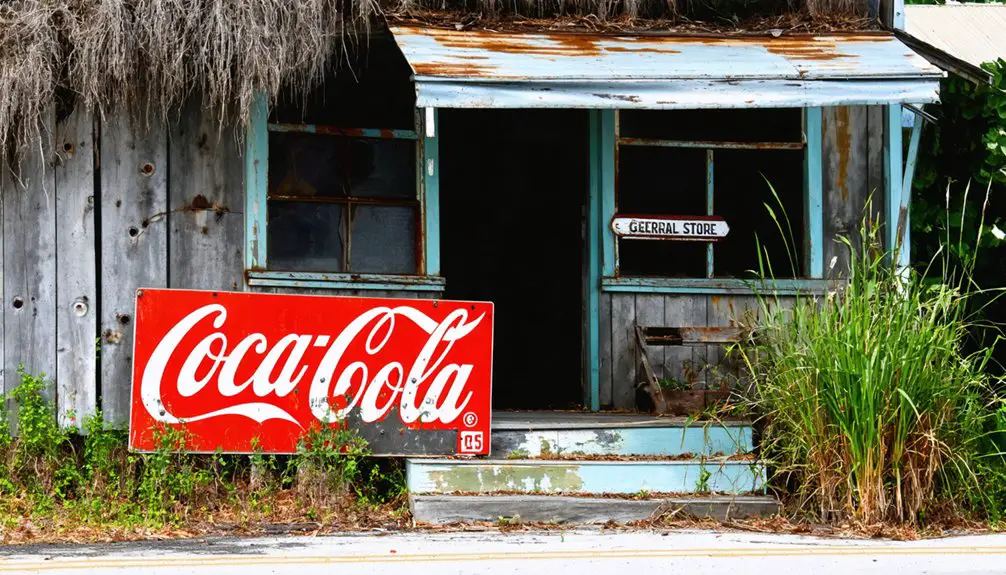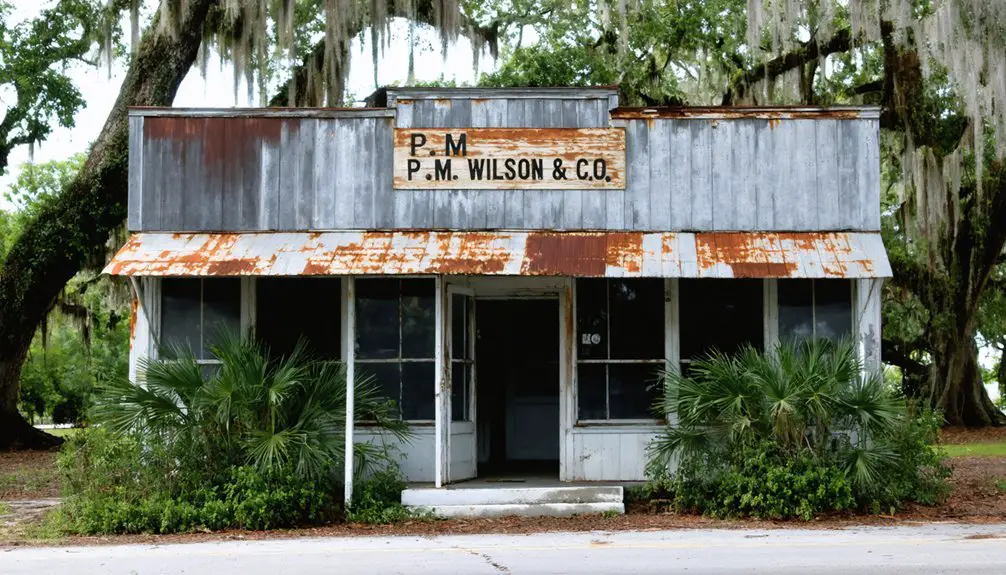You’ll discover Popash, a ghost town in Hardee County, Florida, that began as a hopeful farming settlement in the 1850s. The community, named after local pop ash trees, thrived around New Hope Baptist Church and a bustling post office until 1886, when the railroad bypassed the town in favor of nearby Zolfo Springs. While most structures have vanished, the historic church and cemetery remain, preserving stories of pioneer life and mysterious local legends.
Key Takeaways
- Popash was founded in the 1850s as a farming community along the Peace River in Florida, thriving initially through agriculture and cattle ranching.
- The town’s decline began in 1886 when the railroad bypassed it in favor of nearby Zolfo Springs, severely limiting trade opportunities.
- Key institutions included New Hope Baptist Church (1879), a two-story brick schoolhouse (1898), and a general store (1943).
- Natural disasters, economic challenges, and the Great Depression accelerated Popash’s transformation into a ghost town.
- Today, only New Hope Baptist Church, cemetery, and ruins of the general store and farmhouse remain as testaments to Popash’s history.
The Birth of a Rural Community
While many Florida settlements emerged during the post-Civil War period, Popash’s story began in the 1850s as pioneers established a close-knit farming community in what would later become Hardee County.
You’ll find agricultural roots deeply embedded in this settlement’s foundation, where early residents focused on cattle ranching and farming to sustain their livelihoods.
The community’s resilience became evident as they built essential institutions in the 1870s.
You can trace their determination through the establishment of the New Hope Baptist Church and a post office in 1879, which served the area for eight years before relocating to Zolfo Springs.
The New Hope Cemetery, established near the church, stands as a symbol of the permanent nature of this settlement and the bonds these early pioneers forged.
The town’s distinctive name was inspired by the local pop ash trees that grew in the area.
The arrival of the railroad in 1886 brought promises of growth and prosperity to the area, though these hopes were dashed when the tracks bypassed Popash for Zolfo Springs.
Origins Behind the Distinctive Name
Although the exact origins remain debated, Popash’s distinctive name stems from a prominent tree that early settlers couldn’t definitively identify.
You’ll find that some residents believed it was a poplar, while others insisted it was an ash tree, leading to a combined name that reflected their shared uncertainty. This tree symbolism became deeply woven into the community identity when the town was established between the 1850s and 1870s.
While the post office officially recognized the name in 1879, you won’t find detailed documentation of its origins. Instead, the story lives on through oral traditions, highlighting how natural landmarks shaped frontier settlements. Similar to the Scandinavian families who settled Viking, Florida, early residents left an enduring mark on their community’s identity.
Even after the post office relocated in 1887, locals maintained their connection to this unique name that set them apart from neighboring communities.
Rise of Essential Town Institutions
As Popash emerged in the late 1870s, several essential institutions took root to serve its growing population.
These foundational establishments shaped the town’s character and provided crucial services that strengthened community bonds. The community’s economy centered around cattle and farming, with many residents working in agriculture. Modern visitors can now explore these historical structures through street view options.
- New Hope Baptist Church, established in 1879, became the town’s spiritual heart and primary community gathering space, with its cemetery remaining active today.
- The two-story brick schoolhouse, built in 1898, served as both an educational center and social hub until 1948.
- A general store, constructed in 1943, supplied residents with necessities while fostering local commerce.
- The post office, operating from 1879 to 1887, connected Popash to the wider region until relocating to Zolfo Springs.
These institutions’ rise and eventual decline mirror Popash’s journey from a thriving settlement to a ghost town.
Railroad’s Impact on Town Development
Popash’s bright economic future dimmed in 1886 when the railroad bypassed the town in favor of neighboring Zolfo Springs.
You’ll find that this significant decision stripped Popash of its anticipated growth potential, while Zolfo Springs flourished as the region’s new rail hub. This scenario echoed throughout Florida, where direct rail access determined which communities would thrive economically, as demonstrated by Fort Myers’ post-1899 growth. The development pattern mirrored Florida’s broader transformation during the Industrial Revolution, which saw railroads reshaping the state’s economic landscape.
The railway’s absence left Popash without essential trade connections, condemning it to remain a quiet agricultural community rather than developing into the thriving commercial center its residents had envisioned.
Economic Dreams Derailed
When the Florida Southern Railway announced plans for new rail construction in 1886, residents of Popash envisioned their small agricultural community transforming into a bustling trade center. Their economic aspirations were soon crushed when the railroad bypassed their town in favor of nearby Zolfo Springs, leaving Popash stranded without essential transportation connections.
The impact of this decision proved devastating to Popash’s future:
- Local farmers couldn’t efficiently ship their citrus and produce beyond local markets.
- Transportation limitations prevented commercial growth and diversification.
- Investors and merchants chose rail-connected towns instead.
- Population steadily declined as opportunities dwindled.
While neighboring communities with rail access flourished with new hotels, infrastructure, and commerce, Popash remained trapped in time – a stark reminder of how railroad barons’ routing decisions could make or break a town’s destiny. These rail-connected towns experienced rapid growth as railroads transformed steamboat towns into thriving commercial centers.
Zolfo Springs Wins Instead
The arrival of the Florida Southern Railway in 1886 transformed Zolfo Springs from a quiet sulfur springs settlement into a thriving commercial hub.
While your neighbors in Popash struggled with isolated sand trails, you’d have found Zolfo Springs buzzing with twice-weekly trains carrying passengers and freight to coastal markets.
The railroad advantages were clear: farmers could ship vegetables directly to buyers, phosphate miners had reliable transport for their minerals, and cattle drives along the Florida Cracker Trail gained a valuable shipping point. Before the Atlantic Coast Line arrived in 1912, locals had to make lengthy wagon journeys to reach Zolfo Springs for rail connections. The area’s earliest prosperity came from Florida Cracker Trail cattle herding as far back as 1850.
The community growth spoke for itself – by 1904, you’d have seen an incorporated town with a post office, banking services, and by 1913, modern waterworks from a powerful artesian well.
When Zolfo Springs installed sidewalks in 1917, it signaled the final victory over its unconnected rival.
Life in Early Popash

Life in early Popash revolved around a close-knit agricultural community that took root in the 1850s along the Peace River region of DeSoto County.
Along the Peace River in DeSoto County, Popash emerged as a tight-knit farming settlement in the 1850s.
You’d find families gathering at the two-story brick schoolhouse and New Hope Baptist Church, which served as the heart of local activities.
- You could attend regular church services and family gatherings at New Hope Baptist Church, established in 1879.
- You’d send your kids to school during non-harvest seasons, as classes paused for strawberry picking.
- You’d get your supplies at the local general store while catching up with neighbors.
- You’d participate in seasonal farming and cattle raising, which defined the community’s daily rhythm.
The town’s social fabric was woven through these shared experiences, with residents supporting each other through the challenges of pioneer life.
The Gradual Path to Abandonment
Despite its promising beginnings as an agricultural settlement, Popash’s decline began in 1886 when the railroad bypassed the town in favor of neighboring Zolfo Springs.
You’ll find that this single decision triggered a series of setbacks leading to significant population shifts, as the post office relocated to Zolfo Springs just a year later.
The community decline accelerated when the sawmill burned down in 1898, and recurring floods dampened economic prospects.
Without railroad access, the town struggled to attract new settlers and businesses.
The Great Depression dealt another blow to the already fragile economy.
Remaining Historical Landmarks

Among Popash’s historical landmarks, New Hope Baptist Church stands as a resilient cornerstone of the community since 1879, remaining active and well-preserved across generations.
Across from the church, you’ll find the historic New Hope Cemetery, dating back to the late 1870s, which serves as a crucial connection to the town’s earliest settlers.
- The general store building from 1943 still exists but shows significant deterioration
- An old farmhouse remains partially in ruins on the property
- The New Hope Cemetery maintains active care and continues to draw visitors interested in local history
- The church-cemetery complex represents the most significant remaining structures, preserving Popash’s spiritual and cultural heritage
While many original structures have vanished, these enduring landmarks keep Popash’s memory alive for future generations to explore and understand.
Local Legends and Cultural Legacy
While physical remnants of Popash have largely faded, the town’s cultural legacy endures through a rich tapestry of local legends and oral traditions.
You’ll find the heart of these stories centered around the old school building, where tales of ghostly encounters with children’s spirits have captured imaginations for generations. Though historical records don’t support claims of a hospital or tragic school fire, these stories continue drawing paranormal enthusiasts to the area.
The town’s folklore preservation primarily revolves around New Hope Baptist Church and Cemetery, established in the 1870s, which remain active cultural touchstones.
While the railroad’s bypass in 1886 may have sealed Popash’s economic fate, the community’s spirit lives on through shared narratives and cherished memories passed down through generations.
Frequently Asked Questions
What Was the Peak Population of Popash During Its Most Prosperous Years?
Though exact records don’t exist, you’ll find that population growth likely peaked at under 500 residents before 1886, when demographic changes began as the railroad bypassed this agricultural community.
Are There Any Photographs of Popash From Its Early Days?
You won’t find historic images of early settlers, though some photos exist of the school’s 1912 construction. Most available photographs are from mid-20th century onward, primarily showing abandoned structures.
What Happened to the Families Who Lived in Popash?
Your ancestors scattered like leaves in the wind, with most families migrating to nearby Zolfo Springs after the railroad bypassed them in 1886. Today, only ghost stories and the cemetery preserve their memory.
Can Visitors Still Access the Remaining Structures in Popash Today?
You’ll find limited visitor access to Popash’s remaining structures today. Most are deteriorated and potentially unsafe, with no formal preservation efforts or guided tours. Private property restrictions may also apply.
Were There Any Notable Crimes or Significant Events in Popash’s History?
You won’t find records of notable crimes in Popash’s history. The most significant events were the railroad bypassing the town, post office closure, and school’s evolution from opening to demolition.
References
- https://en.wikipedia.org/wiki/Popash
- https://www.ghosttowns.com/states/fl/popash.html
- https://www.pinterest.com/pin/popash-school–512284526336430277/
- https://en.wikipedia.org/wiki/List_of_ghost_towns_in_Florida
- https://abandonedfl.com/popash-school/
- https://jennmoslekwordpress.wordpress.com/2018/05/02/ghost-towns-of-florida-popash/
- https://freepages.rootsweb.com/~crackerbarrel/genealogy/Popash2.html
- https://www.orlando.gov/Our-Government/Departments-Offices/Public-Works/Water-Reclamation-Division/Orlando-Wetlands/Orlando-Wetlands-History
- https://www.youtube.com/watch?v=TxBONhwNi1k
- https://www.pinterest.com/pin/explore-the-haunting-beauty-of-popash-ghost-town–270356783855715390/



